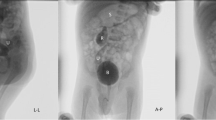Abstract
Newborn male fraternal twins presented at 10 days of age with bilateral flank masses; intravenous urograms showed polycystic kidney disease. Both babies also had hypertrophic pyloric stenosis (HPS). Their father has radiographic and sonographic findings of previously unsuspected polycystic kidneys and has a history of HPS in infancy. The association of dominantly-inherited polycystic kidneys (DPK) and HPS in this family is probably due to chance. However the authors speculate that the autosomal gene for DPK may occur at one of several loci that carry the genetic liability for HPS, a disorder transmitted by polygenic inheritance.
Similar content being viewed by others
References
Bengtsson, U., Hedman, L., Svalander, C.: Adult type of polycystic kidney disease in a new-born child. Acta Med. Scand.197, 447 (1975)
Blyth, H., Ockenden, B. C.: Polycystic disease of the kidneys and liver presenting in childhood. J. Med. Genet.8, 257 (1971)
Carter, C. O., Evans, K. A.: Inheritance of congenital pyloric stenosis. J. Med. Genet.6, 233 (1969)
Dalgaard, O. Z.: Polycystic disease of the kidneys. M. B. Strauss, L. G. Welt, Eds.: Diseases of the Kidney, pp. 1223–1258 (Boston: Little, Brown and Co. 1975
Fellows, R. A., Leonidas, J. C., Beatty, E. C., Jr.: Radiologic features of “adult type” polycystic kidney disease in the neonate. Pediat. Radiol.4, 87 (1976)
Grossman, H., Winchester, P. H., Chisari, F. V.: Roentgenographic classification of renal cystic disease. Am. J. Roentgenol. Radium Ther. Nucl. Med.104, 319 (1968)
Kaye, C., Lewy, P. R.: Congenital appearance of adulttype (autosomal dominant) polycystic kidney disease. J. Pediatr.85, 807 (1974)
MacMahon, B., McKeown, T.: Infantile hypertrophic pyloric stenosis: data on 81 pairs of twins. Acta Genet. Med. Gemellol. (Roma)11, 320 (1955)
Mehrizi, A., Rosenstein, B. J., Pusch, A., Askin, J. A., Taussig, H. B.: Myocardial infarction and endocardial fibroelastosis in children with polycystic kidneys. Bull Johns Hopk. Hosp.115, 92 (1964)
Ritter, R., Siafarikas, K.: Hemihypertrophy in a boy with renal polycystic disease: varied patterns of presentation of renal cystic disease in his family. Pediat. Radiol.5, 98 (1976)
Ross, D. G., Travers, H.: Infantile presentation of adulttype polycystic kidney disease in a large kindred. J. Pediatr.87, 760 (1975)
Six, R., Oliphant, M., Grossman, H.: A spectrum of renal tubular ectasia and hepatic fibrosis. Radiology117, 117 (1975)
Stickler, G. B., Kelalis, P. P.: Polycystic kidney disease: recognition of the “adult form” (autosomal dominant) in infancy. Mayo Clin. Proc.50, 547 (1975)
Author information
Authors and Affiliations
Rights and permissions
About this article
Cite this article
Loh, J.P., Haller, J.O., Kassner, E.G. et al. Dominantly-inherited polycystic kidneys in infants: Association with hypertrophic pyloric stenosis. Pediatr Radiol 6, 27–31 (1977). https://doi.org/10.1007/BF00973811
Accepted:
Issue Date:
DOI: https://doi.org/10.1007/BF00973811




